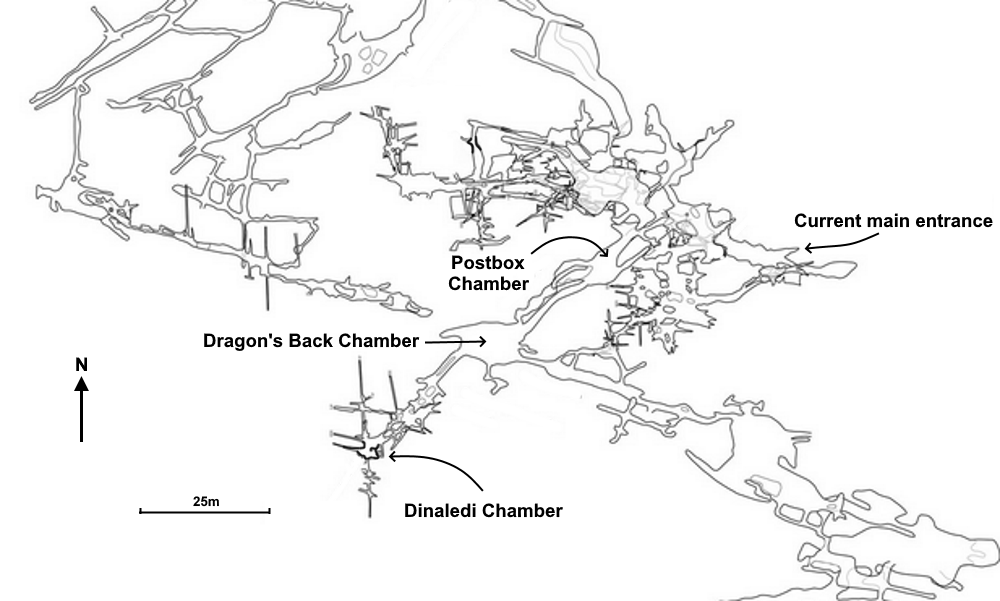
New claims as to the use of fire in Rising Star Cave in South Africa have thrown the spotlight back on the activities of the enigmatic Homo naledi. And it now it appears that there might have been an easier way for these hominins to have made their way into the cave system. Graham Mullan sifts through some new revelations that have flown under experts’ radar.
Rising Star Cave has been close to the centre of attention of the study of early hominins since the first announcement of the finds of Homo naledi back in 2015. Professor Lee Berger of the University of the Witwatersrand in South Africa described how these relatives of modern H. sapiens were discovered in a remote chamber in the cave and conjectured that the remains could only reached their resting place if intentionally brought in by others of the species.
Darkness Below last reported on the site with an in-depth look at the difficulties of working there back in 2018. Recently, there have been announcements about the discovery of the use of fire in several chambers, including Dinaledi Chamber, the site of the majority of the finds of H. naledi, though the publication of this work in advance of any peer review remains controversial.
One of the major talking points about the finds in Rising Star Cave has always been that Dinaledi Chamber is so difficult to access. That these early hominins managed to navigate the tight passages leading there – and even more that they managed to do so while transporting their dead – seemed really remarkable and also somewhat unlikely. But the research team, led by Professor Berger, have always seemed adamant that even in antiquity, there had been no alternative means of accessing the depths of the system where the remains of H. naledi have been found.
From a caver’s perspective, there is an interesting story here that seems to have flown under the radar. A paper published in Chemical Geology a year ago analysed in depth the sediments found throughout the cave system, especially the various flowstone layers. The authors carefully correlated these layers through the cave and described in some detail the depositional history of the site. This paper, titled Providing context to the Homo naledi fossils: Constraints from flowstones on the age of sediment deposits in Rising Star Cave, South Africa, came to two conclusions that bear heavily on the story of this fascinating fossil location.
Firstly, they showed that the finer sediments and probably H. naledi itself, could have entered the cave not through any of the currently accessible entrances but rather through an opening in the roof of Postbox Chamber where they would have been able to climb down from the apex of the debris cone. From there, the route toward the Dragon’s Back Chamber would have been along a passage at that time largely sediment-free. Further, the current crux of the extremely narrow and taxing route to Dinaledi Chamber, up the Dragon’s Back and down the Chute behind the Dragon’s Back block, would have been easily bypassed as the block had not then detached itself from the roof.
The researchers estimate that this block fell in during the same time period that H. naledi was accessing the Dinaledi part of the system, broadly 290-225 ka for the former and 335-241 ka for the latter. There are other obstacles between the postulated Postbox Chamber entrance and Dinaledi Chamber, notably a 5m climb up just beyond the Dragon’s Back block, but overall, the route from the Postbox chamber entrance to Dinaledi Chamber would seem to be about 150m of relatively straightforward caving. This is nothing exceptional – bears have been traversing much longer cave passages for millennia, hibernating and sometimes dying in them. Baboons and even lemurs are known to use caves for sleeping today.
Project lead Lee Berger has not yet publicly addressed the points made in the 2021 paper, on which he is named as co-author, which details the possibility of an alternative and perhaps significantly easier entrance to the system that could have been used by both H. naledi and indeed other hominins. He was asked recently about the possibility of another way into the system, and emphatically answered: “No.”
No
— Lee Berger (@LeeRberger) December 5, 2022
The recent claims about H. naledi and the use of fire, in an area where the researchers freely admit naledi shared the landscape with other hominins, have not yet been subject to peer review. However, Lee Berger is already tweeting that this is not the most important recent discovery:
So. I have a terrible, shameful admission. The fire. It’s not the big discovery I’ve been tweeting about. There’s a bigger one. Actually there are three bigger than fire coming. Sorry.
— Lee Berger (@LeeRberger) December 4, 2022
“It’s impossible to evaluate Lee Berger’s claims properly without seeing the full evidence, but apparently that is forthcoming,” says Chris Stringer of the Natural History Museum in London, a leading expert in the field of early hominins. He adds, “With all due respect to Lee and his teams for a series of great finds, this is not the way to conduct science or progress scientific debate about potentially very important discoveries.”
References:
J.L.Robbins and colleagues – (2021). Providing context to the Homo naledi fossils: Constraints from flowstones on the age of sediment deposits in Rising Star Cave, South Africa. Chemical Geology. 567, 20 April 2021, 120108
